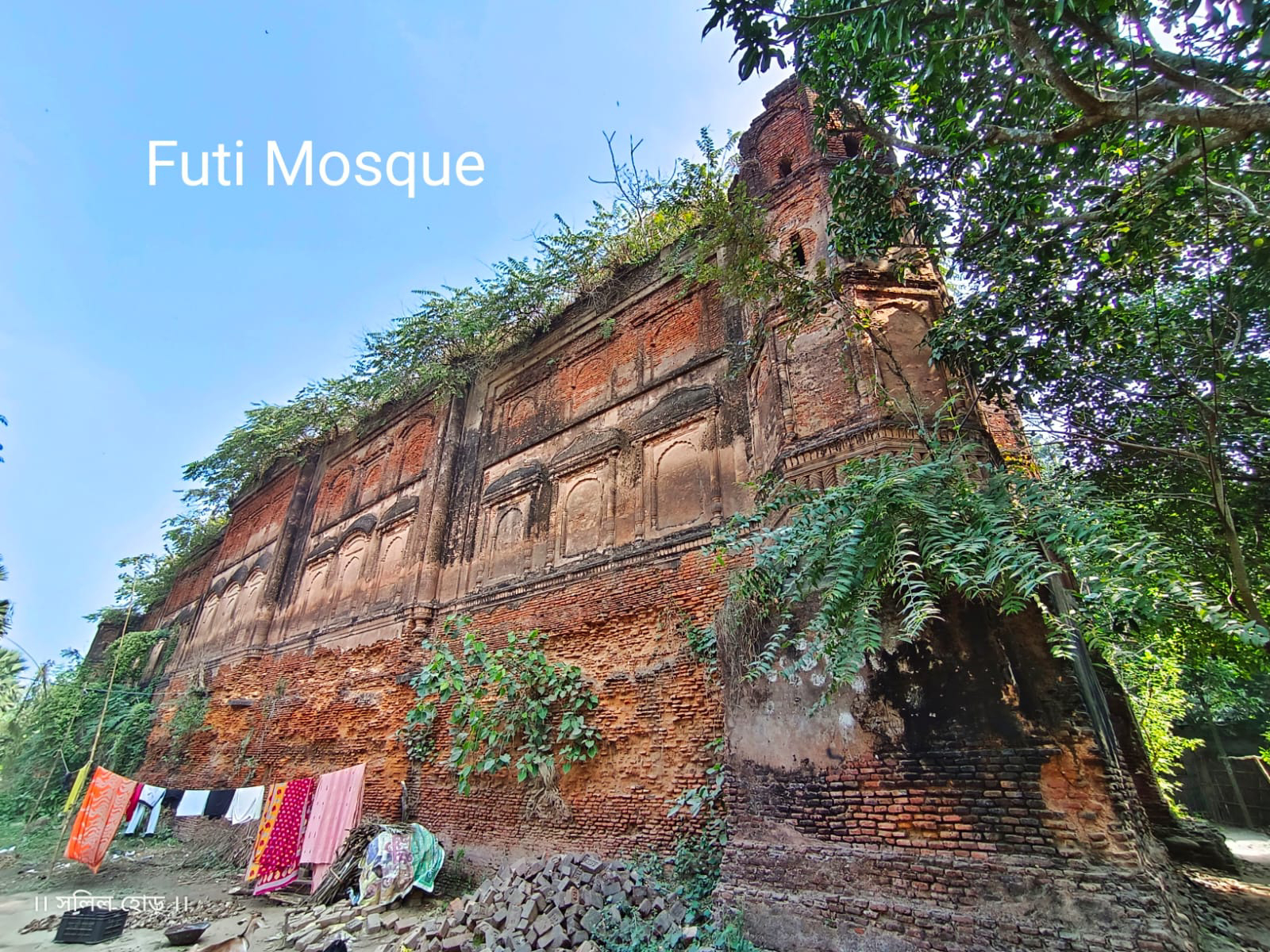নবাব সরফরাজ খাঁ এবং তার অসমাপ্ত ফুটি/ফৌতি মসজিদ, মুর্শিদাবাদ (Nawab Sarfaraz Khan and his incomplete Fouti Mosque, Murshidabad)
নবাব সুজাউদ্দিনের মৃত্যুর পর, পুত্র সরফরাজ খাঁ ১৭৩৯ খ্রিস্টাব্দে বাংলার মসনদে আরোহণ করেন। এনার মায়ের নাম ছিল জিন্নাতউন্নিসা। সুজাউদ্দিন ছিলেন একজন অলস, বিলাসী, এবং ধর্মভীরু নবাব। তার সময়ে হারেমে ১৫০০ বেগম এবং মসজিদে ১০০ বেতনভোগী মোল্লা রাখতেন। সমস্ত রাজ্যের দায়ভার তিনি মন্ত্রিসভার ওপরে দিয়ে, নিজে রমণীবিলাসে দিন কাটাতেন। এরফলে কিছুদিনের মধ্যেই মন্ত্রণাসভার লোকজনের সাথে তার মতবিরোধ দেখা দিলো, এবং তারা নেমে পড়লেন সরফরাজকে সিংহাসন থেকে সরানোর কাজে।
পারস্য সম্রাট নাদিরশাহ দিল্লি আক্রমণ করেই মোরাদ খাঁ ও সরবলন্দ খাঁকে পঞ্চাশ জন অশ্বারোহী দিয়ে বাংলায় পাঠালেন রাজস্ব আদায়ের জন্য। নবাব তাদের রাজস্ব প্রদান করলেন। নাদির শাহ পারস্য ফিরে যেতেই দিল্লি সিংহাসনে বসলেন মুঘল সম্রাট মহম্মদ শাহ, এবং চাইলেন রাজস্ব। নবাব একই বছরে দুবার রাজন্ব দিতে অস্বীকার করেন। সুযোগ বুঝে হাজি আহম্মদ, আলমচাঁদ ও জগৎশেঠ দিল্লির সম্রাটকে দিলেন উৎকোচ ও প্রতিশ্রুতি, যে এই বছরই দেবেন রাজস্ব, কিন্তু তার বিনিময়ে চাই বাংলা বিহার উড়িষ্যার নবাবি ফরমান। সম্রাট রাজী হলেন। হাজি আহম্মদের ভাই আলিবর্দীকে, সরফরাজের বিরুদ্ধে যুদ্ধে নামিয়ে দেওয়া হলো। গিরিয়ার যুদ্ধে ১৭৪০ খ্রিস্টাব্দে নবাব সরফরাজ খাঁ, আলিবর্দির কাছে পরাজিত ও নিহত হন।
গিরিয়ার যুদ্ধের বহ বৎসর পূর্বেই তিনি একটি বিরাট আকৃতির মসজিদের নির্মাণকার্য শুরু করেন। কিন্ত যুদ্ধে আলিবর্দির হাতে আকস্মিক মৃত্যু হওয়ার কারণে মসজিদটি অসম্পূর্ণ থেকে যায়। সরফরাজ খাঁর পর আরও অন্তত ১৬ জন নবাব বাংলা মসনদে বসলেও সরফরাজ খাঁর স্বপ্নের মসজিদটির নির্মাণকাজ আর সম্পন্ন করেন নি কেউ। এর একটা বড়ো কারণ হিসেবে আমার মনে হয়, সরফরাজ খাঁর মৃত্যুর সঙ্গে সঙ্গেই নাসিরি রাজবংশের পতন ঘটে, এবং আলীবর্দী খাঁয়ের হাত ধরে পত্তন হয় আফসার রাজবংশের। সেই কারণে, এই মসজিদটির নাম হয় 'ফৌতি/ফুটি মসজিদ'।
কাটরা মসজিদ যেতে লালগোলা-শিয়ালদহ রেলক্রসিংটি পার হলেই মূল সড়ক থেকে হাতের বা দিকেই চোখে পড়বে এই মসজিদটি। রাস্তা থেকে নেমে নিচু পথ ধরে যেতে হয় মসজিদটিতে। মসজিদটি অনেক উঁচু ঢিবির উপর অবস্থিত। মসজিদে ওঠার কোনো সিঁড়ি নেই। বেশ কষ্ট করেই মসজিদে উঠতে হয়। চারদিকে ইট-সুরকির দেয়াল, অসম্পূর্ণ ছাদ, মাটির মেঝে। বয়সের ভারে পড়ো পড়ো অবস্থা। শেওলা, আগাছা, পরগাছায় ছেয়ে গেছে অনেক জায়গা। মসজিদ সংলগ্ন জায়গা অনেক আগেই বেদখল হয়ে গেছে। তবু মসজিদের দেওয়ালে কিছু কারুকাজ আজও চোখে পড়ে।
পাঁচটি গম্বুজ ও চারটি মিনারযুক্ত এই মসজিদটি একশ পঁয়ত্রিশ ফুট লম্বা এবং আটত্রিশ ফুট চওড়া। বর্তমানে মিনারগুলো থাকলেও, গম্বুজগুলো ধসে পড়েছে। ঠিকঠাকভাবে সম্পুর্ণ করতে পারলে, তৎকালীন মুর্শিদাবাদের একটি বৃহৎ স্থাপত্য হতো এটি। এই মসজিদের মেঝে মাটির হওয়ায়, ভিতরে অনেক আগাছা জন্মেছে। দেওয়ালের কাজ অসম্পূর্ণ থাকলেও, এতদিন পরেও কিছু কারুকার্য দেখতে পাওয়া যায়। মসজিদের নির্মাণের বিষয়ে অনেক ভৌতিক গল্প চালু থাকলেও, বিষয়টি আমার সম্পূর্ণ অবাস্তব লেগেছে।
প্রায় তিনশত বছর নির্মাণের অপেক্ষায় দাঁড়িয়ে থেকে ক্লান্ত হয়ে, অবহেলিত ইতিহাসের এক নীরব সাক্ষী হয়ে নির্জন অন্ধকারে শেষ প্রহর গুনছে এই মসজিদটি।
(English Version)
Nawab Sarfaraz Khan and his Incomplete Fouti Mosque, Murshidabad
After Nawab Shuja-ud-Din's demise, his son Sarfaraz Khan ascended the throne of Bengal in 1739 AD. His mother's name was Zinat-un-Nisa. Shuja-ud-Din was an indolent, pleasure-seeking, and pious Nawab. During his reign, he maintained 1500 begums in his harem and employed 100 salaried mullahs in his mosque. He entrusted all state responsibilities to his cabinet, while he indulged in a life of luxury. This soon led to disagreements with his council members, who then began efforts to depose Sarfaraz.
Upon attacking Delhi, the Persian Emperor Nadir Shah dispatched Murad Khan and Sarbaland Khan to Bengal with fifty horsemen to collect revenue. The Nawab duly paid the revenue. As soon as Nadir Shah returned to Persia, the Mughal Emperor Muhammad Shah ascended the Delhi throne and demanded revenue. The Nawab refused to pay revenue twice in the same year. Seizing this opportunity, Haji Ahmed, Alamchand, and Jagat Seth bribed the Delhi emperor and promised him the year's revenue, but in return, they sought the Nizamat of Bengal, Bihar, and Orissa. The Emperor agreed. Haji Ahmed's brother, Alivardi Khan, was then sent to war against Sarfaraz. In the Battle of Giria in 1740 AD, Nawab Sarfaraz Khan was defeated and killed by Alivardi.
Many years before the Battle of Giria, Sarfaraz Khan had begun the construction of a magnificent mosque. However, his sudden death at the hands of Alivardi in battle left the mosque unfinished. Although at least 16 more Nawabs ascended the throne of Bengal after Sarfaraz Khan, none completed the construction of his dream mosque. A major reason for this, in my opinion, is that the Nasirid dynasty fell with Sarfaraz Khan's death, and the Afsharid dynasty was founded by Alivardi Khan. For this reason, the mosque came to be known as 'Fouti/Futi Mosque' (Fouti meaning "fallen" or "incomplete").
You can spot this mosque just past the Lalgola-Sealdah railway crossing when heading towards Katra Mosque; it's on the left off the main road. One must descend a low path from the road to reach the mosque. The mosque stands on a high mound. There are no stairs to ascend to the mosque, making the climb quite difficult. It features brick and mortar walls, an incomplete roof, and an earthen floor. It appears to be on the verge of collapse due to age. Moss, weeds, and parasitic plants cover many areas. The land adjacent to the mosque has long been encroached upon. Nevertheless, some intricate carvings are still visible on the mosque's walls.
This mosque, originally designed with five domes and four minarets, measures one hundred and thirty-five feet in length and thirty-eight feet in width. While the minarets still stand today, the domes have collapsed. If it had been properly completed, it would have been a grand architectural marvel of Murshidabad at the time. As the mosque's floor is earthen, many weeds have grown inside. Despite the unfinished wall work, some carvings can still be seen after all these years. While many ghostly tales circulate regarding the mosque's construction, I find them entirely unrealistic.
Tired from waiting nearly three centuries for completion, this mosque now silently counts its last moments in desolate darkness, a forgotten and neglected witness to history.









Comments
Post a Comment